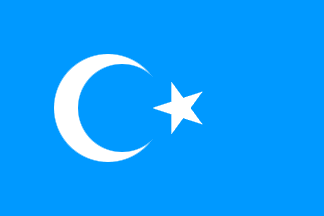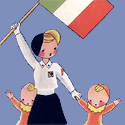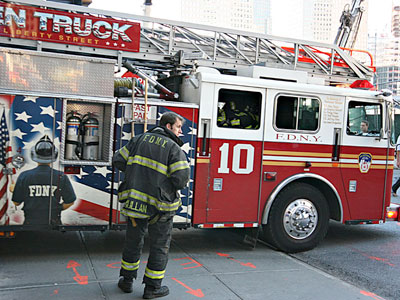nationalism
Uyghurstan

The Kökbayraq is a flag without a country.
Seen at protests around the world in recent weeks, the flag is used by Uygur nationalists in the East Turkestan independence movement and the more militant East Turkestan Islamic Movement and East Turkestan Liberation Organization. The flag is banned in China.
The design has its origins in two briefly independent republics. In 1933, when the Chinese central government had de facto ceased to exist, the Islamic Republic of Eastern Turkestan declared independence. It collapsed the following year, though a second Republic won independence a decade later with Soviet support. It was crushed in 1949 by the People’s Liberation Army of Communist China, when it became designated “Xinjiang Uyghur Autonomous Region.”
Fire Engine Red
Shooting off fireworks, firing up the grill, raining fire on Charlie — there’s much collective fire-making in the name of Americanness. But in NYC at least, fire fighting has also taken this on.
It’s fairly common here to see fire houses and fire trucks decorated with Americana: all manner of murals and bas-relief flags, eagles, and slogans honoring our troops, etc. This is particularly keen where fire houses have affixed street-level memorials to the firefighters who lost their lives on September 11, 2001. In graphics and text, these both pay tribute to the fallen and position them at the front-line of American defense.
Of course there are firefighters around the world, but here in the States the idea of a bunch of brawny, self-sacrificing heros swooping in when you need them most has become particularly hyper-American, particularly in the shadow of foreign attack.
But in its messaging, it’s seldom acknowledged that this vanguard of Americanness, these rugged individualists are almost always organized as a socialist or anarchist endeavor, either funded by the city or as volunteer collectives from the communities they serve. Seldom that is, until services are cut.
Come Over and Help Us
 Noam Chomsky on early American branding and a history of torture in the USA:
Noam Chomsky on early American branding and a history of torture in the USA:
“The inspirational phrase ‘city on a hill’ was coined by John Winthrop in 1630, borrowing from the Gospels, and outlining the glorious future of a new nation ‘ordained by God.’ One year earlier his Massachusetts Bay Colony created its Great Seal. It depicted an Indian with a scroll coming out of his mouth. On that scroll are the words ‘Come over and help us.’ The British colonists were thus pictured as benevolent humanists, responding to the pleas of the miserable natives to be rescued from their bitter pagan fate.
The Great Seal is, in fact, a graphic representation of ‘the idea of America,’ from its birth.… The Great Seal was an early proclamation of ‘humanitarian intervention,’ to use the currently fashionable phrase. As has commonly been the case since, the ‘humanitarian intervention’ led to a catastrophe for the alleged beneficiaries. The first Secretary of War, General Henry Knox, described ‘the utter extirpation of all the Indians in most populous parts of the Union’ by means ‘more destructive to the Indian natives than the conduct of the conquerors of Mexico and Peru.’”
Typographic Diplomacy
 AFP reports that the President of Taiwan today suggested that Taiwan adopt the simplified character set used in mainland China. The choice of script is clear political signal to Beijing towards reconciliation. The pro-Independence party is none too pleased. The Taiwanese-government funded Central News Agency is less alarmist, reporting that the President really encouraged learning simplified characters along side traditional characters.
AFP reports that the President of Taiwan today suggested that Taiwan adopt the simplified character set used in mainland China. The choice of script is clear political signal to Beijing towards reconciliation. The pro-Independence party is none too pleased. The Taiwanese-government funded Central News Agency is less alarmist, reporting that the President really encouraged learning simplified characters along side traditional characters.
In last summer’s article on Typography and Nationalism about countries switching scripts, I included this bit about the simplified script:
Chinese script reform has its roots in the 19th century, but Mao Zedong gave it the force of law. (Mao, a calligrapher himself, must have been keenly aware of the power of type.) A month after taking power in 1949, the Communist Party established the Language Reform Committee to simplify written Chinese. The move was intended to promote literacy and unify the nation, but it also worked to crush the many local languages within China’s borders.
The Nationalist-led government of Taiwan, however, never adopted the simplified characters preferring instead to continue using the traditional script. The choice of type has since marked a key cultural wedge between Taiwan and China.
Tiny Nationalisms
 Eleanor Roosevelt famously wrote, “Where, after all, do universal human rights begin? In small places, close to home.“ By implication, the same could be said for racism, nationalism and other ideologies.
Eleanor Roosevelt famously wrote, “Where, after all, do universal human rights begin? In small places, close to home.“ By implication, the same could be said for racism, nationalism and other ideologies.
Official Representations of the Nation: Comparing the Postage Stamps of Sudan and Burkina Faso looks at the ideology of stamps:
“Sudan’s stamps focus on the political center and dominant elite (current regime, Khartoum politicians, and Arab and Islamic identity) while Burkina Faso’s stamps focus on society (artists, multiple ethnic groups, and development). Sudan’s stamps build an image of the nation as being about the northern-dominated regime in Khartoum (whether military or parliamentary); Burkina Faso’s stamps project an image of the nation as multi-ethnic and development-oriented.”
Ethnic identity is, of course, a tool in the Sudan government’s repression of Darfur.
 Video of Steven Heller narrating a few themes from his new book Iron Fists: Branding the 20th-Century Totalitarian State, showing images of symbols, youth and of the “great leader” in fascist Germany and Italy and communist Russia and China.
Video of Steven Heller narrating a few themes from his new book Iron Fists: Branding the 20th-Century Totalitarian State, showing images of symbols, youth and of the “great leader” in fascist Germany and Italy and communist Russia and China.
Typography and Nationalism
An article I wrote on typography and nationalism is out now in the July/August 2008 issue of PRINT. The full text is online here.
This is an idea I’ve had simmering for a couple of years, so it’s nice to finally see it in public. In the end, I only had 1,300 words to use so there’s some interesting material I had to cut. (One could write a dissertation on the subject.) But I think the arc of it comes across.
Some of that material and a few other points of reference are filed in the typography category of this blog.

Update 7/18/2009: The article is now available in Italian and Russian.
The King Never Smiles
 Excerpt on photography and nationalism in Thailand, from The King Never Smiles: A Biography of Thalians’s Bhumobol Adulyadej by Paul M. Handley:
Excerpt on photography and nationalism in Thailand, from The King Never Smiles: A Biography of Thalians’s Bhumobol Adulyadej by Paul M. Handley:
“At each juncture his power and influence increased, rooted in his silent charisma and prestige. Thais, who believe it is their land’s fortune, their karma, to be blessed with such a king, saw a man who worked tirelessly for them without reward or pleasure. His sacrifice was readily visible: while Thais are known for their gracious smiles and bawdy humor, and a what-will-be fatalism, King Bhumibol alone is serious, gray, and almost tormented by the weighty matters of his realm. Ever since the day his brother mysteriously died [in 1946, when Bhumibol ascended to the throne], he seemed never to be seen smiling, instead displaying an apparent penitential pleasurelessness in the trappings and burdens of the throne.
For Thais, this was a sign of his spiritual greatness. In Buddhist culture, either a smile or a frown would indicate attachment to worldly pleasures or desires. Bhumibol’s public visage was unfailingly one of kindly benevolence and impassivity. In his equanimity he resembled the greatest kings of the past, the dhammarajas of the 13th-century Sukhothai kingdom who were called Chao Phaendin, Lord of the Land, and Chao Cheevit, Lord of Life. Increasingly many Thais compared his noble sacrifice to the Buddha’s own.”
Photo from a 2006 subway mural in Bangkok, part of the King‘s 60th anniversary celebrations.


